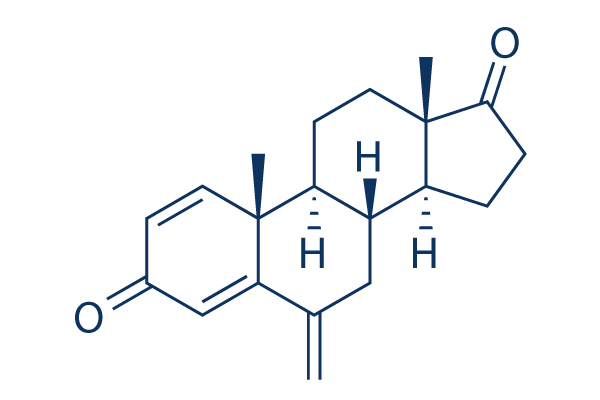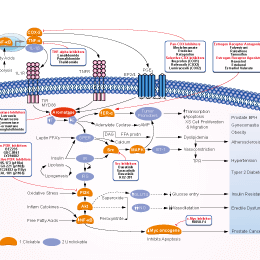
- Bioactive Compounds
- By Signaling Pathways
- PI3K/Akt/mTOR
- Epigenetics
- Methylation
- Immunology & Inflammation
- Protein Tyrosine Kinase
- Angiogenesis
- Apoptosis
- Autophagy
- ER stress & UPR
- JAK/STAT
- MAPK
- Cytoskeletal Signaling
- Cell Cycle
- TGF-beta/Smad
- Compound Libraries
- Popular Compound Libraries
- Customize Library
- Clinical and FDA-approved Related
- Bioactive Compound Libraries
- Inhibitor Related
- Natural Product Related
- Metabolism Related
- Cell Death Related
- By Signaling Pathway
- By Disease
- Anti-infection and Antiviral Related
- Neuronal and Immunology Related
- Fragment and Covalent Related
- FDA-approved Drug Library
- FDA-approved & Passed Phase I Drug Library
- Preclinical/Clinical Compound Library
- Bioactive Compound Library-I
- Bioactive Compound Library-Ⅱ
- Kinase Inhibitor Library
- Express-Pick Library
- Natural Product Library
- Human Endogenous Metabolite Compound Library
- Alkaloid Compound LibraryNew
- Angiogenesis Related compound Library
- Anti-Aging Compound Library
- Anti-alzheimer Disease Compound Library
- Antibiotics compound Library
- Anti-cancer Compound Library
- Anti-cancer Compound Library-Ⅱ
- Anti-cancer Metabolism Compound Library
- Anti-Cardiovascular Disease Compound Library
- Anti-diabetic Compound Library
- Anti-infection Compound Library
- Antioxidant Compound Library
- Anti-parasitic Compound Library
- Antiviral Compound Library
- Apoptosis Compound Library
- Autophagy Compound Library
- Calcium Channel Blocker LibraryNew
- Cambridge Cancer Compound Library
- Carbohydrate Metabolism Compound LibraryNew
- Cell Cycle compound library
- CNS-Penetrant Compound Library
- Covalent Inhibitor Library
- Cytokine Inhibitor LibraryNew
- Cytoskeletal Signaling Pathway Compound Library
- DNA Damage/DNA Repair compound Library
- Drug-like Compound Library
- Endoplasmic Reticulum Stress Compound Library
- Epigenetics Compound Library
- Exosome Secretion Related Compound LibraryNew
- FDA-approved Anticancer Drug LibraryNew
- Ferroptosis Compound Library
- Flavonoid Compound Library
- Fragment Library
- Glutamine Metabolism Compound Library
- Glycolysis Compound Library
- GPCR Compound Library
- Gut Microbial Metabolite Library
- HIF-1 Signaling Pathway Compound Library
- Highly Selective Inhibitor Library
- Histone modification compound library
- HTS Library for Drug Discovery
- Human Hormone Related Compound LibraryNew
- Human Transcription Factor Compound LibraryNew
- Immunology/Inflammation Compound Library
- Inhibitor Library
- Ion Channel Ligand Library
- JAK/STAT compound library
- Lipid Metabolism Compound LibraryNew
- Macrocyclic Compound Library
- MAPK Inhibitor Library
- Medicine Food Homology Compound Library
- Metabolism Compound Library
- Methylation Compound Library
- Mouse Metabolite Compound LibraryNew
- Natural Organic Compound Library
- Neuronal Signaling Compound Library
- NF-κB Signaling Compound Library
- Nucleoside Analogue Library
- Obesity Compound Library
- Oxidative Stress Compound LibraryNew
- Plant Extract Library
- Phenotypic Screening Library
- PI3K/Akt Inhibitor Library
- Protease Inhibitor Library
- Protein-protein Interaction Inhibitor Library
- Pyroptosis Compound Library
- Small Molecule Immuno-Oncology Compound Library
- Mitochondria-Targeted Compound LibraryNew
- Stem Cell Differentiation Compound LibraryNew
- Stem Cell Signaling Compound Library
- Natural Phenol Compound LibraryNew
- Natural Terpenoid Compound LibraryNew
- TGF-beta/Smad compound library
- Traditional Chinese Medicine Library
- Tyrosine Kinase Inhibitor Library
- Ubiquitination Compound Library
-
Cherry Picking
You can personalize your library with chemicals from within Selleck's inventory. Build the right library for your research endeavors by choosing from compounds in all of our available libraries.
Please contact us at [email protected] to customize your library.
You could select:
- Antibodies
- Bioreagents
- qPCR
- 2x SYBR Green qPCR Master Mix
- 2x SYBR Green qPCR Master Mix(Low ROX)
- 2x SYBR Green qPCR Master Mix(High ROX)
- Protein Assay
- Protein A/G Magnetic Beads for IP
- Anti-Flag magnetic beads
- Anti-Flag Affinity Gel
- Anti-Myc magnetic beads
- Anti-HA magnetic beads
- Poly FLAG Peptide lyophilized powder
- Protease Inhibitor Cocktail
- Protease Inhibitor Cocktail (EDTA-Free, 100X in DMSO)
- Phosphatase Inhibitor Cocktail (2 Tubes, 100X)
- Cell Biology
- Cell Counting Kit-8 (CCK-8)
- Animal Experiment
- Mouse Direct PCR Kit (For Genotyping)
- New Products
- Contact Us
Exemestane
Synonyms: FCE24304, PNU155971,EXE
Exemestane is an aromatase inhibitor, inhibits human placental and rat ovarian aromatase with IC50 of 30 nM and 40 nM, respectively.

Exemestane Chemical Structure
CAS: 107868-30-4
Selleck's Exemestane has been cited by 22 Publications
2 Customer Reviews
Purity & Quality Control
Batch:
Purity:
99.96%
99.96
Exemestane Related Products
| Related Compound Libraries | FDA-approved Drug Library Natural Product Library Bioactive Compound Library-I Exosome Secretion Related Compound Library Human Hormone Related Compound Library | Click to Expand |
|---|
Signaling Pathway
Choose Selective Aromatase Inhibitors
Cell Data
| Cell Lines | Assay Type | Concentration | Incubation Time | Formulation | Activity Description | PMID |
|---|---|---|---|---|---|---|
| human MCF7a cells | Cytotoxicity assay | 10 days | Cytotoxicity against human MCF7a cells expressing Tet-off-3betaHSD1-Arom assessed as inhibition of TST-stimulated cell proliferation measured after 10 days, EC50=5.6 nM | 22951074 | ||
| human MCF7 cells | Cytotoxicity assay | 10 to 15 μM | 3-6 days | Cytotoxicity against human placental microsome aromatase expressing human MCF7 cells assessed as reduction in cell viability at 10 to 15 uM after 3 to 6 days by MTT assay in presence of estradiol | 25277066 | |
| Click to View More Cell Line Experimental Data | ||||||
Biological Activity
| Description | Exemestane is an aromatase inhibitor, inhibits human placental and rat ovarian aromatase with IC50 of 30 nM and 40 nM, respectively. | ||||
|---|---|---|---|---|---|
| Features | 17-hydroexemestane is the principal metabolite of Exemestane. | ||||
| Targets |
|
| In vitro | ||||
| In vitro | Exemestane competitively inhibits and time-dependently inactivates of human placental aromatase with Ki of 4.3 nM. Exemestane displaces [3H]DHT from rat prostate androgen receptor with IC50 of 0.9 μM. [1] Exemestane (1 μM) increases alkaline phosphatase activity in hFOB and Saos-2 cells and induces the expression of MYBL2, OSTM1, HOXD11, ADCYAP1R1, and glypican 2 in hFOB cells. [2] Exemestane causes aromatase degradation in a dose-responsive manner in MCF-7aro cells. [3] |
|||
|---|---|---|---|---|
| Kinase Assay | Assays with human placental aromatase | |||
| Microsomes are prepared from human placenta and stored at -80℃. The rate of aromatization is determined by measuring the tritiated water released from [1β-3H]A. The assay is carried out in a final volume of 1 mL, in 10 mM phosphate buffer, pH 7.5, containing 100 mM KCl, 1 mM EDTA, 1 mM dithiothreitol, 100 μM NADPH, the enzyme preparation and the appropriate concentrations of Exemestane (in duplicate) and the substrate. After a 10 min incubation at 37 ℃, the assay is terminated by the addition of 4 mL cold chloroform. The acqueous phase is treated with a charcoal suspension, the supernatant is removed and counted for radioactivity by liquid scintillation in Rialuma. For the determination of the IC50 values, various concentrations of Exemestane are incubated with 20 μg of microsomal protein, in the presence of a fixed amount (50 nM) of [3H]A. | ||||
| Cell Research | Cell lines | hFOB cells | ||
| Concentrations | 1 μM | |||
| Incubation Time | 24 hours | |||
| Method | hFOB is treated with steroids and Exemestane for 24 hours, when specimens are harvested and evaluated for cell proliferation using the WST-8 method. Optical densities (OD, 450 nm) are evaluated using a SpectraMax 190 microplate reader and Softmax Pro 4.3 microplate analysis software. The status of proliferation (%) is calculated according to the following equation: (cell OD value after test materials treated /vehicle control cell OD value)× 10 |
|||
| In Vivo | ||
| In vivo |
Exemestane increases lumbar spine BMD by 14.0% in OVX rats at dose of 100 mg/kg. Exemestane (100 mg/kg) and 17-hydroexemestane (20 mg/kg) significantly reduces an ovariectomy-induced increase in serum pyridinoline and serum osteocalcin in rats and causes significant reductions of serum cholesterol and low-density lipoprotein cholesterol inOVX rats. [4] Exemestane (20 mg/kg/day s.c.) induces 26% complete (CR) and 18% partial (PR) tumor regressions in rats with 7,12-dimethylbenzanthracene (DMBA)-induced mammary tumors. [5] |
|
|---|---|---|
| Animal Research | Animal Models | estrogen-deficient ovariectomized (OVX) rats |
| Dosages | 100 mg/kg | |
| Administration | Intramuscular injection | |
| NCT Number | Recruitment | Conditions | Sponsor/Collaborators | Start Date | Phases |
|---|---|---|---|---|---|
| NCT04296565 | Recruiting | Mild Cognitive Impairment |
VA Office of Research and Development |
January 3 2022 | Phase 4 |
| NCT04692909 | Unknown status | Food Addiction|Obesity Morbid |
Soroka University Medical Center |
January 15 2021 | Not Applicable |
| NCT04572295 | Active not recruiting | Breast Neoplasms |
Eisai Co. Ltd.|Eisai Inc. |
October 9 2020 | Phase 1 |
Chemical Information & Solubility
| Molecular Weight | 296.4 | Formula | C20H24O2 |
| CAS No. | 107868-30-4 | SDF | Download Exemestane SDF |
| Smiles | CC12CCC3C(C1CCC2=O)CC(=C)C4=CC(=O)C=CC34C | ||
| Storage (From the date of receipt) | |||
|
In vitro |
DMSO : 54 mg/mL ( (182.18 mM); Moisture-absorbing DMSO reduces solubility. Please use fresh DMSO.) Ethanol : 15 mg/mL Water : Insoluble |
Molecular Weight Calculator |
|
In vivo Add solvents to the product individually and in order. |
In vivo Formulation Calculator |
||||
Preparing Stock Solutions
Molarity Calculator
In vivo Formulation Calculator (Clear solution)
Step 1: Enter information below (Recommended: An additional animal making an allowance for loss during the experiment)
mg/kg
g
μL
Step 2: Enter the in vivo formulation (This is only the calculator, not formulation. Please contact us first if there is no in vivo formulation at the solubility Section.)
% DMSO
%
% Tween 80
% ddH2O
%DMSO
%
Calculation results:
Working concentration: mg/ml;
Method for preparing DMSO master liquid: mg drug pre-dissolved in μL DMSO ( Master liquid concentration mg/mL, Please contact us first if the concentration exceeds the DMSO solubility of the batch of drug. )
Method for preparing in vivo formulation: Take μL DMSO master liquid, next addμL PEG300, mix and clarify, next addμL Tween 80, mix and clarify, next add μL ddH2O, mix and clarify.
Method for preparing in vivo formulation: Take μL DMSO master liquid, next add μL Corn oil, mix and clarify.
Note: 1. Please make sure the liquid is clear before adding the next solvent.
2. Be sure to add the solvent(s) in order. You must ensure that the solution obtained, in the previous addition, is a clear solution before proceeding to add the next solvent. Physical methods such
as vortex, ultrasound or hot water bath can be used to aid dissolving.
Tech Support
Answers to questions you may have can be found in the inhibitor handling instructions. Topics include how to prepare stock solutions, how to store inhibitors, and issues that need special attention for cell-based assays and animal experiments.
Tel: +1-832-582-8158 Ext:3
If you have any other enquiries, please leave a message.
* Indicates a Required Field
Tags: buy Exemestane | Exemestane supplier | purchase Exemestane | Exemestane cost | Exemestane manufacturer | order Exemestane | Exemestane distributor








































